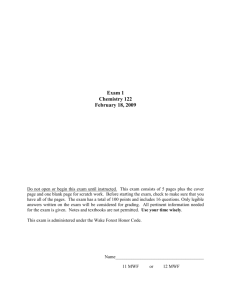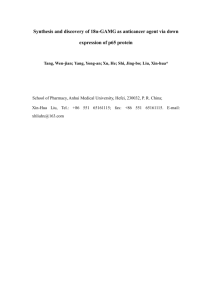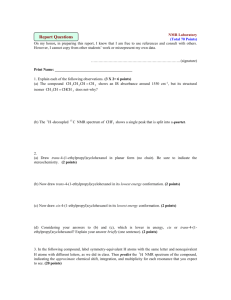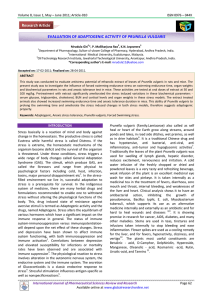A New Phenylpropanoid and Triterpenoids from Prunella vulgaris
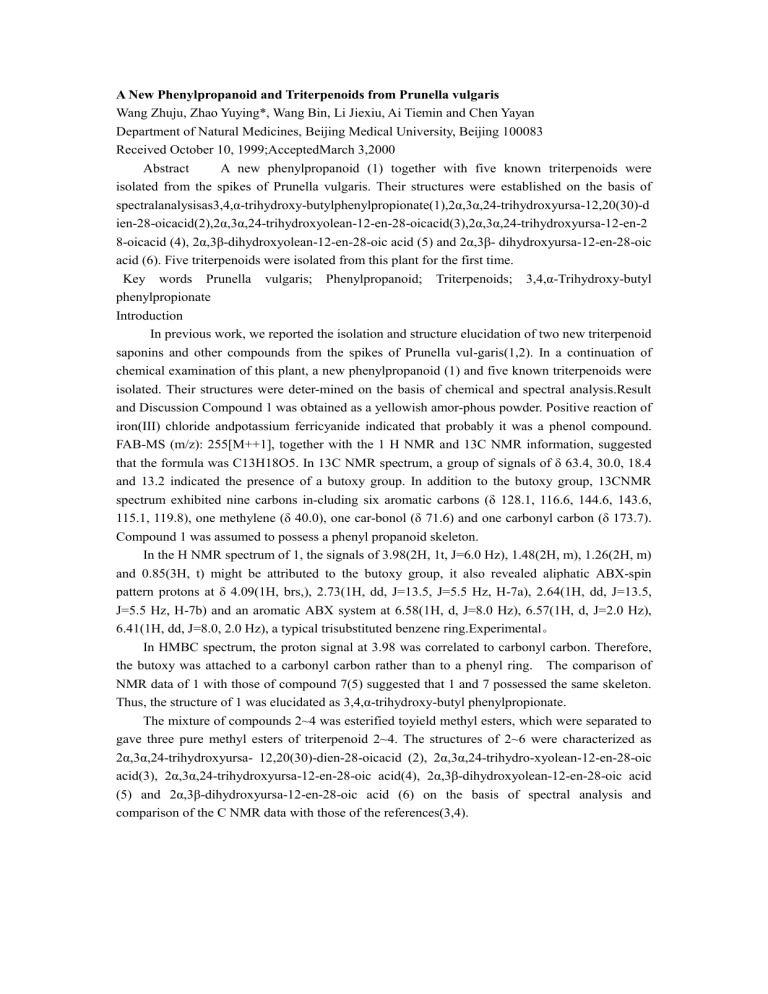
A New Phenylpropanoid and Triterpenoids from Prunella vulgaris
Wang Zhuju, Zhao Yuying*, Wang Bin, Li Jiexiu, Ai Tiemin and Chen Yayan
Department of Natural Medicines, Beijing Medical University, Beijing 100083
Received October 10, 1999;AcceptedMarch 3,2000
Abstract A new phenylpropanoid (1) together with five known triterpenoids were isolated from the spikes of Prunella vulgaris. Their structures were established on the basis of spectralanalysisas3,4,α-trihydroxy-butylphenylpropionate(1),2α,3α,24-trihydroxyursa-12,20(30)-d ien-28-oicacid(2),2α,3α,24-trihydroxyolean-12-en-28-oicacid(3),2α,3α,24-trihydroxyursa-12-en-2
8-oicacid (4), 2α,3β-dihydroxyolean-12-en-28-oic acid (5) and 2α,3β- dihydroxyursa-12-en-28-oic acid (6). Five triterpenoids were isolated from this plant for the first time.
Key words Prunella vulgaris; Phenylpropanoid; Triterpenoids; 3,4,α-Trihydroxy-butyl phenylpropionate
Introduction
In previous work, we reported the isolation and structure elucidation of two new triterpenoid saponins and other compounds from the spikes of Prunella vul-garis(1,2). In a continuation of chemical examination of this plant, a new phenylpropanoid (1) and five known triterpenoids were isolated. Their structures were deter-mined on the basis of chemical and spectral analysis.Result and Discussion Compound 1 was obtained as a yellowish amor-phous powder. Positive reaction of iron(III) chloride andpotassium ferricyanide indicated that probably it was a phenol compound.
FAB-MS (m/z): 255[M++1], together with the 1 H NMR and 13C NMR information, suggested that the formula was C13H18O5. In 13C NMR spectrum, a group of signals of δ 63.4, 30.0, 18.4 and 13.2 indicated the presence of a butoxy group. In addition to the butoxy group, 13CNMR spectrum exhibited nine carbons in-cluding six aromatic carbons (δ 128.1, 116.6, 144.6, 143.6,
115.1, 119.8), one methylene (δ 40.0), one car-bonol (δ 71.6) and one carbonyl carbon (δ 173.7).
Compound 1 was assumed to possess a phenyl propanoid skeleton.
In the H NMR spectrum of 1, the signals of 3.98(2H, 1t, J=6.0 Hz), 1.48(2H, m), 1.26(2H, m) and 0.85(3H, t) might be attributed to the butoxy group, it also revealed aliphatic ABX-spin pattern protons at δ 4.09(1H, brs,), 2.73(1H, dd, J=13.5, J=5.5 Hz, H-7a), 2.64(1H, dd, J=13.5,
J=5.5 Hz, H-7b) and an aromatic ABX system at 6.58(1H, d, J=8.0 Hz), 6.57(1H, d, J=2.0 Hz),
6.41(1H, dd, J=8.0, 2.0 Hz), a typical trisubstituted benzene ring.Experimental
。
In HMBC spectrum, the proton signal at 3.98 was correlated to carbonyl carbon. Therefore, the butoxy was attached to a carbonyl carbon rather than to a phenyl ring. The comparison of
NMR data of 1 with those of compound 7(5) suggested that 1 and 7 possessed the same skeleton.
Thus, the structure of 1 was elucidated as 3,4,α-trihydroxy-butyl phenylpropionate.
The mixture of compounds 2~4 was esterified toyield methyl esters, which were separated to gave three pure methyl esters of triterpenoid 2~4. The structures of 2~6 were characterized as
2α,3α,24-trihydroxyursa- 12,20(30)-dien-28-oicacid (2), 2α,3α,24-trihydro-xyolean-12-en-28-oic acid(3), 2α,3α,24-trihydroxyursa-12-en-28-oic acid(4), 2α,3β-dihydroxyolean-12-en-28-oic acid
(5) and 2α,3β-dihydroxyursa-12-en-28-oic acid (6) on the basis of spectral analysis and comparison of the C NMR data with those of the references(3,4).
Experimental
Apparatus and reagents UV spectra were recorded on Shimadzu UV-260 pectrometer. 1D- and 2D-NMR spectra were taken on ruker AM-500 (500 MHz for H and 125 MHz for C)
1 13 pectrometer. FAB-MS were recorded on Zabspec mass pectrometer. High performance liquid chromatography as carried out using Gilson automatic system for reparative HPLC with chromatographic column of lltima C18 (10 μm, 60A, 22×250 mm ID). Silica gel Marine Chemical
Plant, Qingdao) and Sephadex LH-20 Ouya New Technique Company) were used for hromatographic separations. Dried spikes of P. vulgaris as purchased from Hebei Anguo Herbal
Medicine arket in August 1997 and has been identified by rofessor Wang Xuan in the Division of
Pharmacognosy nd a sample was deposited in the Division of Natural edicine Chemistry, Beijing
Medical University. Extraction and Isolation Dried spike powder (20 kg) was extracted with 95% thanol and 50% ethanol successively. The 95% ethanol xtract was concentrated under reduced pressure and was xtracted with petroleum ether, chloroform and n-butanol uccessively. The n-butanol extract (510 g) was issolved in water to obtain 200 g water-insoluble sub- tances.
The water insoluble part was chromatographed ver silica gel column eluted with gradient solvent sysem of CHCl3-MeOH (10:1 to 3:1) to afford 220 fracons (250 ml each fraction).
Fractions 6~9 were sub-ected to silica gel column chromatography, Sephadex O2Me LH-20 column chromatography, and finally preparative HPLC (70% MeOH as solvent system) to afford compound 1 (55 mg). The 50% ethanol extract was also partitioned between water and chloroform, n-butanol. The chloroform extract (47 g) was subjected to silica gel olumn chromatography eluted with CHCl3-MeOH gradient system to give 250 fractions (250 ml/Fr). Fractions233~244 were chromatographed over silica gel column with CHCl3-MeOH(95:5) to afford a white powder.
The white powder was first treated with diazomethane at oom temperature, then subjected to
HPLC preparation o yield three methyl ester of compounds 2 (38 mg), 3 42 mg) and 4 (45 mg).
Fractions 147~150 were ecrystallized to obtain a white amorphous solid (46 mg) which contained compounds 5 and 6.
Compound 5 and compound 6 were a mixture obained as white amorphous solid. It gave positive Lieermann-Burchard reaction. IR(KBr)cm-1: 3390, 2936, 687, 1547, 1452, 1386, 1375,
1309, 1272, 1240, 1184, 105, 1085, 1048, 1030, 995, 959, 922, 864, 826, 810, 58, 735, 661; 13C
NMR data (see Table 1) were in acordance with those of 2α,3β-dihydroxyolean-12-en-28ic acid and 2α,3β-dihydroxyursa-12-en-28-oic acid(4).
Acknowledgment
This program was supported by National Natural Science Foundation of China.
References
1 Wang ZJ, Zhao YY and Chen YY. Acta Pharm Sin, 1999, 34: 679
2 Tian J, Xiao ZY, Chen YY, Zhao YY and Wang ZJ. Acta Pharm Sin, 2000,35: 29
3 Kojima H. Tominaga Hand Sato S. Phytochemistry, 1987, 26: 1107
4 KojimaH and Ogura H. Phytochemistry, 1986,25: 729
5 Hao H. J Nat Prod, 1996,59: 1079


